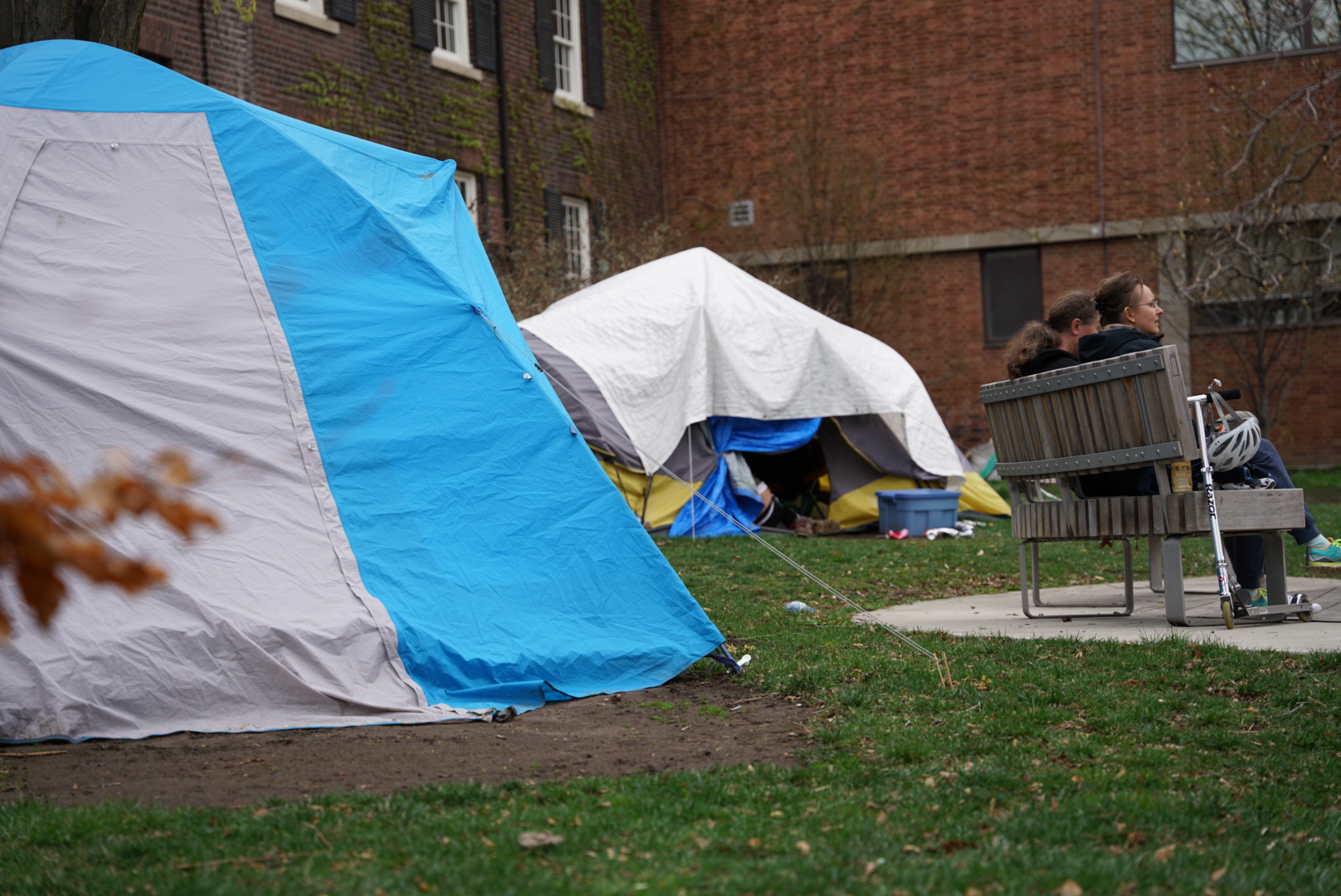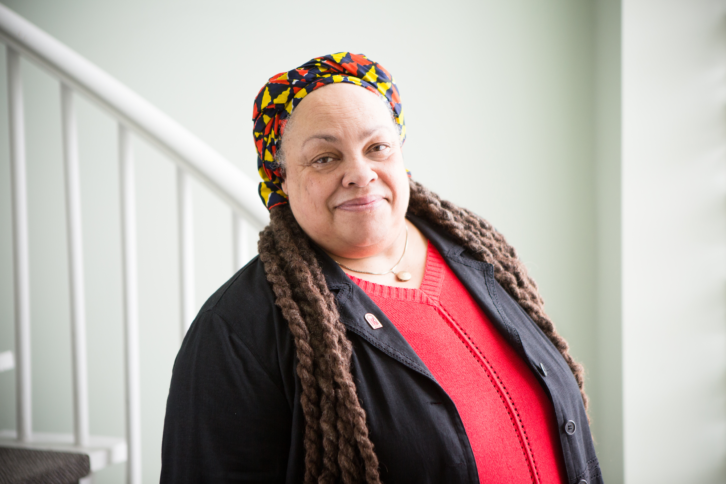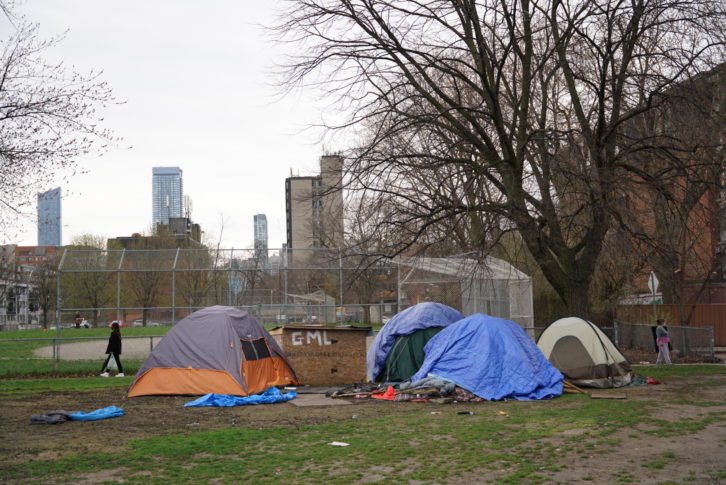COVID in Toronto
Staying safe a daily struggle for the homeless

caption
Those experiencing homelessness in Toronto have continued sleeping in public spaces like Grange Park during the pandemic.City's efforts to house the most vulnerable fall short
Editor's Note
These data-driven stories on COVID-19 were prepared by King's MJ students.
COVID-19 has hit the homeless in Toronto particularly hard, exacerbating problems that have existed for years.
When the city announced the first case of COVID-19 in its shelter system in March 2020, more than 6,500 people were staying in homeless shelters. Three months later, that number dropped to 4,300 and has continued trending downward.
Fear of infection drove some residents outdoors, to escape the risk of infection in indoor spaces. Limits on capacity introduced to fight COVID-19 also reduced available spaces.
Last year in a March 17 news release, the city announced new isolation spaces for people entering the shelter system while they waited for COVID-19 test results. At that time, there were no confirmed cases in the shelter system.
A little more than a year later, there have been over 1,300 confirmed cases of COVID-19 in Toronto shelters.
The city began vaccinating those in the shelter system two months ago, but shelter occupancy numbers have not bounced back.
And the numbers housed remain well below those before the pandemic hit.
In a list of highlights released by the city on March 10, 2021, the city said it had moved more than 3,600 people throughout the shelter system in the past year to more than 25 new temporary shelter hotel locations, to maintain distancing.
Shelter operators were receiving updated information daily and had to ensure their shelters were following protocols.
Carol Latchford said she struggled to keep on top of everything. She’s executive director at Red Door Family Shelter, just east of the downtown core.
“Pivot became my favourite word because you were constantly trying to manage the fears around the shelter, while at the same time providing the latest information and staying on top of screening and protocols. It was really difficult.”

caption
Carol LatchfordRed Door Family Shelter houses families and women experiencing violence in the Toronto area.
Latchford said providing accurate information was especially important early in the pandemic because of their specific clientele.
“There were rumours going around that the women’s shelter sites were closed,” she said.
“But this was when a lot of reorganizing was going on to account for proper spacing between beds, but they were never actually closed.”
Despite the rumours and new spacing rules, Red Door itself did not experience the drop in occupancy shown in the city’s occupancy data.
“I think you have to put it in context. The new spacing arrangements have led to a lot of people moving to new spaces,” she said.
Managing the added stress of clients and staff as new outbreaks are announced is a constant battle for Red Door staff.
“It’s impacted everyone differently,” she said. “The shelter clients and staff of course are very fearful,”
A January 2021 study published in the Canadian Medical Association Journal suggested those fears were justified.
It found that at the height of the first wave from March 14 to June 16 last year, people with a recent history of homelessness were more than 20 times more likely to be hospitalized from COVID-19 and five times more likely to die within 21 days of testing positive.
As the second wave hit Toronto, the risk of infection in city shelters kept occupancy numbers low. But many shelters across the city still have limited space.

caption
Alexandra Park is one of the four largest encampment communities in Toronto.As of April 26, according to the city’s daily shelter census, family shelter programs operating at 90.5 per cent of the current available capacity, and singles shelter programs 94.5 per cent.
There were 7,871 actively homeless people in Toronto in February this year, city data indicate. The city estimates that based on the most recent Street Needs Assessment, 18 per cent of people experiencing homelessness are not reflected in this data.
Accounting for the 18 per cent absent from the data, this means the city has almost 3,000 more people actively experiencing homelessness than there are spaces for those people in shelters.
The lack of proper space and fear of infection have prompted more use of the city’s parks for shelter.
“Sleeping rough”
Early in the pandemic, due to the provincial stay-at-home order, the city stopped clearing out the encampments in Toronto parks.
On March 16, 2021, the city announced a new program focusing on people living in four “priority areas:” Moss Park, Alexandra Park, Trinity Bellwoods and Lamport Stadium. The Pathway Inside program aimed to move some of those living in the parks to a temporary shelter program operated by Homes First Society at 45 The Esplanade in the downtown core.
Hania Ahmed, the communications director for Homes First Society shelters, said in an e-mail, “One of our biggest concerns is the safety of those living in encampments. Through this program, we’re hoping to support those living in encampments to stabilize their lives and break the cycle of homelessness.”
In an news release April 1, the city suspended new referrals to the Esplanade program after four new cases of COVID-19 were identified. There were 14 active cases from that outbreak as of April 27.
Alykhan Pabani, a volunteer with the Encampment Support Network, said the risk of infection is a major reason people may be avoiding using temporary shelters.

caption
Alykhan Pabani“It’s tricky because the city is saying they’ve opened up safer spaces but they’re not safer and they’re not even adequate even if they were safe,” Pabani said.
The Encampment Support Network is a volunteer advocacy group that delivers supplies to people living in public parks.
Since the first lockdown in Toronto last year, Pabani said he’s seen more people living in parks, despite the city’s efforts to move them inside.
“I think it skyrocketed overnight when the first lockdown hit because of COVID capacity restrictions in shelters,” he said.
“With the warmer months coming up, it’s definitely ballooning again.”
Mapping outbreaks
This map shows outbreaks that occurred this year in shelter settings. You can click the arrows to see a legend.
Community spread is a major concern as several shelters in the downtown core announce outbreaks at shelter programs. Seven shelter outbreaks have occurred in the Moss Park and Yonge-Church Corridor neighbourhoods since the beginning of 2021.
But Pabani said a problem with moving people to temporary shelter programs outside the downtown core is the lack of access to support systems and services.
“People need to be close to the services they need. Folks rely on each other for harm reduction,” he said.
“In the hotels they do have regular checks. It’s tough to build those kinds of relationships in those environments.”
Pabani said ESN is not convinced the city’s Pathway Inside program is the right solution.
“It’s a steady rebranding of what’s essentially the same process of displacement,” he said.
“At the end of the day, it’s these same coercive tactics based on this bylaw that prohibits people from camping in parks.”
Instead, Pabani said the city needs to focus efforts on creating more affordable housing instead of enforcing the clearing of encampments.
Latchford agreed.
“I would love to see the city’s long-term housing plan fully realized. We’ve just got to see more housing made available to folks that is affordable and safe,” she said.
The path forward
Creating new affordable housing is just one piece in a larger puzzle of solving longstanding problems.
As vaccination continues, community spread in shelters will slowly decline. This may ease infection concerns and encourage people to return to shelter programs, but problems remain.
“Vaccinations will offer a certain amount of protection, but the new problem is around these variants,” Latchford said.
“When they get into shelters, they spread like wildfire and they’re much harder to manage,” she said.
Ahmed said continuing to control spread within their spaces is a priority in Homes First shelters.
Six Homes First shelters hosted vaccination clinics in March and more than 400 residents and staff received a dose of a COVID-19 vaccine, she said.
“We hope that with continued vaccination and maintaining COVID-19 safety protocols, we can reduce and eliminate the risk of spread in our shelters.”
In an e-mail, Kris Sheuer, the city’s Senior Communications Advisor, said the city will continue its current response efforts, including services at temporary shelter sites until the end of the year.
“Leases, where required, will be extended until the end of the year or replacement sites secured where an extension cannot be secured,” she said.
Pabani said like many, he is hesitant to let his guard down.
“Whether people are vaccinated or not, wherever they’re living, they’re still waiting too long for permanent housing,” he said.
“At the end of the day it’s too slow, it’s too little and it’s too far in the future.”
About the author
Benjamin Elliott
Ben Elliott is a reporter for the Signal at King's College in Halifax. He got his HBA in Communication Studies from the University of Waterloo...

J
Julie Elliott